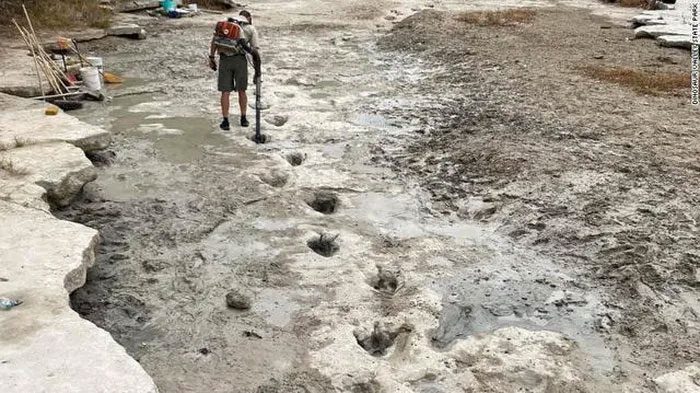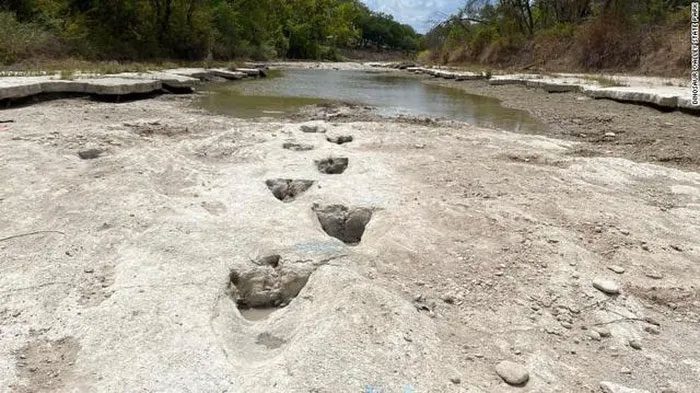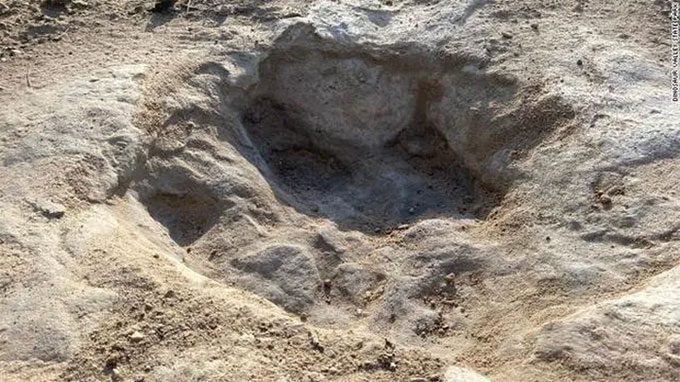Dinosaur footprints dating back approximately 113 million years have been discovered at Dinosaur Valley State Park in Texas.
“Most of the recently uncovered footprints are from the species Acrocanthosaurus. This dinosaur species could stand on two legs when fully grown, reaching nearly 5 meters in height and weighing up to 7 tons“, said park spokesperson Stephanie Salinas Garcia in an email to CNN.

Acrocanthosaurus is a genus of theropod dinosaurs that once inhabited what is now North America during the Aptian stage and the early Albian stage of the Cretaceous period. Like most other dinosaur genera, Acrocanthosaurus has only one known species: A. atokensis.
Garcia further noted that some of the footprints found in the park in Glen Rose, Texas, belong to the Sauroposeidon dinosaur species, which could reach about 18 meters in height and weigh nearly 50 tons when fully grown.
This summer’s extreme drought has caused a river in the park to completely dry up, revealing dinosaur-era footprints.
According to the U.S. Drought Monitor, over 60% of Texas has experienced severe drought conditions in the past week, and recent days have seen heat waves raising temperatures, leading to heat warnings for millions.

Sauroposeidon is a genus of sauropod dinosaurs belonging to the Brachiosauridae family that lived during the early Late Cretaceous, around 112 million years ago. It is known from a few incomplete specimens, including a sediment layer containing bones and fossil footprints found in what are now the states of Oklahoma, Wyoming, and Texas.
The human-induced climate crisis has also increased the likelihood of extreme weather events during droughts and heavy rainfall, such as the flash floods experienced this week in the Dallas area.
Under normal weather conditions, dinosaur footprints are rarely discovered in submerged areas and unburied sediments; however, the drought has made these tracks more accessible.
Garcia stated, “Although these newer dinosaur footprints may only be visible for a short period, they bring a sense of wonder and excitement about discovering new dinosaur tracks in the park.” “Dinosaur Valley State Park will continue to protect these 113 million-year-old footprints not only for the present but also for future generations.”
How Can Dinosaur Footprints Become Fossilized?

Fossilized dinosaur footprints form under different conditions than the dinosaurs themselves.
One of the peculiarities of dinosaur footprints is that they fossilize under conditions different from those of the dinosaurs themselves. A complete dinosaur skeleton, with fully articulated joints, including impressions of soft tissues, often forms under sudden, catastrophic circumstances, such as when a Parasaurolophus is buried by a sandstorm, drowns in a flash flood, or accidentally falls into a tar pit. In contrast, footprints can only fossilize if they are perfectly preserved by the environment and not disturbed by the footprints of other species.
The necessary conditions for dinosaur footprints to survive for 100 million years are that the footprints must be imprinted in soft clay (for example, along lakeshores, coastlines, or riverbeds), and then dried by sunlight.
If all necessary conditions are perfectly met, these fossilized footprints can survive even after being buried under successive layers of sediment. This means that dinosaur footprints are not necessarily only found on the surface. They can also be recovered from deep underground, similar to conventional fossils.
Which Dinosaurs Could Have Created Fossilized Footprints?
Except for special cases, it is very challenging to determine the specific genus or species of dinosaur that created a particular footprint. What paleontologists can relatively easily determine is whether the dinosaur was bipedal or quadrupedal (meaning it walked on two or four legs), the geological period in which it lived (based on the age of the sediment where the footprint was found), and its approximate size and weight (based on the footprint’s size and depth).
Paleontologists can only extract a limited amount of information from a single dinosaur footprint. However, by analyzing the stride of a dinosaur—both the distance between the left and right feet and the forward direction of movement—researchers can make accurate guesses about the dinosaur’s posture and weight distribution.
This can help determine whether the dinosaur was running instead of walking and, if so, at what speed.
Dinosaur footprints are sometimes found in groups, (if the footprints appear similar) which are considered evidence of herd behavior. Multiple footprints in a parallel line may indicate mass migration.





















































